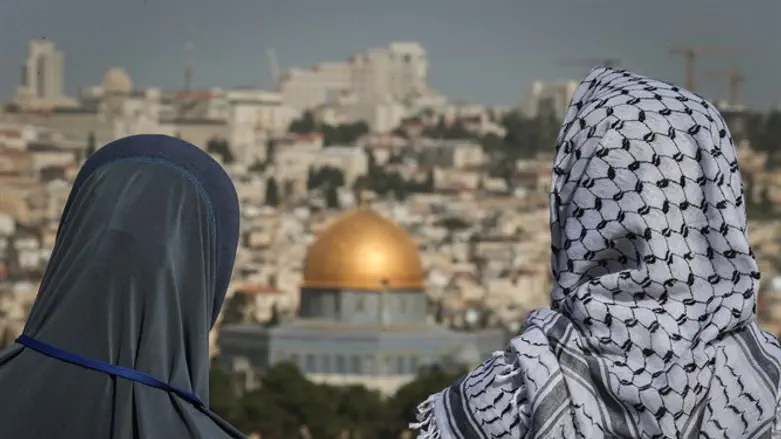
Will the capital of the Jewish state have an Arab majority in the near future?
Israel’s National Security Council is weighing various options for preserving Jerusalem’s shrinking Jewish majority, as experts warn that an ongoing flood of Arab migration into the city from the Palestinian Authority will completely reshape the demographic balance in the holy city.
Jews have constituted a majority of Jerusalem’s population going back at least to the 19th century. In 1944, as the Second World War raged on and a full four years before Israel achieved independence, Jews made up about 62% of the city’s total population.
Following the city’s reunification under Israeli sovereignty in 1967, three out of every four Jerusalemites were Jewish.
Over the past half century, however, the demographic balance in the Israeli capital has shifted dramatically, with a net Jewish migration out of the city and Arab migration into Jerusalem.
While Jews made up 72% of the city’s population in 1980 and 68% in 2000, over the past fifteen years, the demographic shift has accelerated dramatically. Despite the city’s large Orthodox Jewish population and relatively high fertility rate, from 2000 to 2015, the Jewish population increased by just 17%, due to the net migration of Jews out of the city as housing prices there skyrocketed.
According to Israel’s Central Bureau of Statistics, the city’s Jewish majority fell to just 61% in 2015. Senior Jerusalem Center for Public Affairs researcher Nadav Shragai warns that since 2015, that figure has fallen even further, dropping below 60%.
“We’re fast approaching the dangerous situation in which 50% of Jerusalem is Arab,” Shragai said, according to a Makor Rishon report Sunday night.
While the high birthrate among the city’s Muslim Arab residents has contributed to part of the demographic change, Shragai suggests that the unauthorized immigration of tens of thousands of Palestinian Authority residents into the city may be the primary driver of the rapid increase in the Arab population.
In 2003, Israel built a security barrier - part fence, part wall – around the city’s eastern border as part of the larger security fence separating pre-1967 Israel from the Palestinian Authority.
While most of the city’s Arab neighborhoods are to the west of the fence, several neighborhoods were effectively separated from the city by the barrier, sitting to the east of the wall.
Since then, the so-called “isolated neighborhoods” – including part of Shuafat and Kafr Aqab (Kfar Akab) have become increasingly lawless, with high crime rates, scant law enforcement, and fewer and fewer municipal services provided by the City of Jerusalem as the security situation deteriorated.
Yet the Arab neighborhoods on the east side of the barrier have seen an explosive level of growth – tripling their total population since 2003 to 140,000. By comparison, Shragai notes, the total population of Arab neighborhoods ‘inside’ the barrier have increased by just 71% over that same period.
Unencumbered by building inspectors or police interference, massive illegal housing projects have been built in neighborhoods like Kafr Aqab and Shuafat, including even ten-story apartment buildings.
Due to the law enforcement vacuum in the isolated neighborhoods, wildcat building projects have flourished and the average price of new apartments have dropped to under 400,000 shekels ($115,000) – cheaper even than many comparable apartments in Palestinian Authority-controlled cities.
That has drawn a flood of immigration from the PA, with tens of thousands of Palestinian Arabs illegally residing in neighborhoods on the edge of Jerusalem – outside the security barrier but still under Israeli sovereignty and within Jerusalem’s municipal boundaries.
According to Shragai, as many as 40% of the 140,000 Arabs living in Jerusalem neighborhoods east of the barrier are actually PA residents. These 56,000 or so illegal Arab residents make up about 18% of the city’s total Arab population. Discounting them from the city’s population statistics means that among legal residents, Jerusalem’s Jewish population is about 66%, compared to between 31% and 32% of legal residents who are Arab.
Given the demographic change in the capital, Israeli political leaders have presented a series of proposals aimed at preserving Jerusalem’s Jewish majority.
Last year, Jerusalem Mayor Nir Barkat reportedly pushed for the demolition of six illegal high-rise apartment buildings in Kafr Aqab. The demolition, to be carried out using a series of explosive charges, would open up space for a planned road and demonstrate that Israeli sovereignty still applies to the area.
Since the initial report on the planned demolition, however, the Jerusalem District Court has placed a temporary order blocking the operation.
Lawmakers have offered up more comprehensive solutions, including the proposed “Greater Jerusalem Law” being pushed by Transportation Minister Yisrael Katz (Likud).
The law, if passed, would expand the municipal borders of Jerusalem to include the city of Maaleh Adumim to the east, which is currently home to nearly 38,000 Israelis. In addition, the town of Givat Zeev to the northwest, the city of Beitar Illit to the south, the town of Efrat, and other communities in Gush Etzion would all be incorporated into Jerusalem.
It would not, however, officially annex these areas to Israel.
According to Transportation Minister Yisrael Katz (Likud), the plan would add some 150,000 Jews to the city, increasing the total population to over one million.
Jerusalem Affairs Minister Zeev Elkin (Likud) offered an alternative plan, which would establish a separate municipal body to administer some of the city’s Arab neighborhoods and enforce Israeli law there.
A third option, proposed by Anat Berko (Likud), would cede municipal authority over neighborhoods outside of the security barrier, like Kafr Aqab, to the Palestinian Authority.
